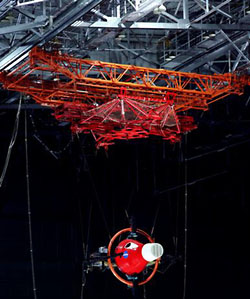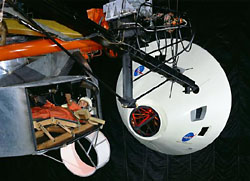
The National Aeronautics and Space Administration (NASA) used the Rendezvous Docking Simulator at the Langley Research Center in Hampton, Virginia, to train Gemini and Apollo astronauts in docking procedures they had to master before attempting to land on the moon. NASA engineers decided that the best method of accomplishing President Kennedy's goal of a moon landing by 1969 was through a lunar orbit rendezvous (LOR). The LOR called for a single Saturn V launch of two spacecraft into lunar orbit. One would remain in orbit while the other would descend to the moon and then boost itself back into lunar orbit, rendezvous and dock with the mother ship before returning to earth. To accomplish this task it was essential that Apollo astronauts be trained in all aspects and problems likely to arise in an attempt to dock the Apollo Command and Lunar Excursion Modules in lunar orbit. Failure to dock would result in the failure of the entire mission and the likely loss of the lives of the astronauts. The Rendezvous Docking Simulator gave the astronauts the experience of docking the spacecraft in a safe environment that closely resembled a space environment. Only when the Apollo astronauts had successfully mastered rendezvous and docking skills in the Rendezvous Docking Simulator would NASA give permission for the attempt to land on the moon.

Following the completion of the Apollo program, the Rendezvous Docking Simulator was modified to solve open-and-closed loop pilot control problems, aircraft landing approaches, simulator validation studies and passenger ride quality studies. The name of the facility was changed to the Real-Time Dynamic Simulator. At present, this facility is inactive.
Visit the National Park Service Travel American Aviation to learn more about Aviation related Historic Sites.
Last updated: August 28, 2017
